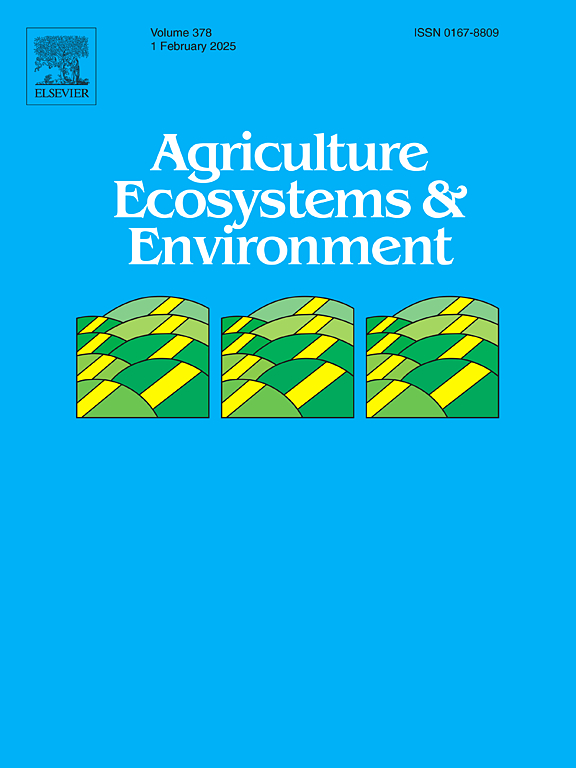Mechanisms of soil organic matter persistence vary across time and soil depth in long-term cropping systems of the North Central US
IF 6.4
1区 农林科学
Q1 AGRICULTURE, MULTIDISCIPLINARY
引用次数: 0
Abstract
Soil organic matter (SOM) declines under agricultural production have been well documented, despite efforts to maintain or enhance SOM through practices like rotational diversity and increased carbon (C) input quantity and quality. However, a critical knowledge gap remains in understanding how system management alters the microbial processes that drive C input turnover and stabilization across time and soil depths. This study addresses this gap by leveraging a long-term cropping systems trial to investigate microbial mechanisms of SOM turnover and stabilization across a representative range of cropping systems in the North Central US. We assessed microbial and chemical soil characteristics at two key sampling times throughout the growing season and linked these measurements to indicators of SOM persistence. Particulate organic matter (POM) C:N exhibited significant (P < 0.001) variation across cropping systems, depth, and time reflecting a gradient of system C input quality. POM-C was greatest in pasture systems (P < 0.001) at both time points, suggesting stability of the relationship between POM inputs and decomposition across the growing season. Additionally, microbial growth and respiration were highest in pasture (P > 0.001), which was consistent across time, indicating an active microbial community that facilitates SOM turnover and stabilization. Our findings provide novel insights on the role of rotational and plant input diversity for enhancing microbial turnover and slowing SOM decline through POM substrate quality, particularly in pasture systems, across time and soil depths. This research will serve to inform future cropping system-level soil management strategies aimed at improving SOM persistence.
美国中北部长期种植系统土壤有机质持久性机制随时间和土壤深度的变化而变化
尽管通过轮作多样性和增加碳(C)输入的数量和质量等措施努力维持或提高土壤有机质(SOM),但农业生产条件下土壤有机质(SOM)的下降已得到充分证明。然而,一个关键的知识差距仍然存在于理解系统管理如何改变微生物过程,驱动C输入的周转和稳定随时间和土壤深度的变化。本研究通过利用长期种植系统试验来研究美国中北部具有代表性的种植系统中SOM周转和稳定的微生物机制,从而解决了这一差距。我们在整个生长季节的两个关键采样时间评估了微生物和化学土壤特征,并将这些测量结果与SOM持久性指标联系起来。颗粒有机质(POM) C:N在不同种植制度、种植深度和种植时间上表现出显著(P <; 0.001)的变化,反映了系统C输入质量的梯度。在两个时间点上,POM- c在牧场系统中最大(P <; 0.001),表明POM投入与分解之间的关系在整个生长季节具有稳定性。此外,牧草的微生物生长和呼吸最高(P >; 0.001),这在不同的时间点上是一致的,表明活跃的微生物群落促进了SOM的周转和稳定。我们的研究结果为轮作和植物输入多样性在通过POM基质质量促进微生物周转和减缓SOM下降中的作用提供了新的见解,特别是在牧场系统中,跨越时间和土壤深度。这项研究将有助于为未来的种植系统级土壤管理策略提供信息,旨在提高SOM的持久性。
本文章由计算机程序翻译,如有差异,请以英文原文为准。
求助全文
约1分钟内获得全文
求助全文
来源期刊

Agriculture, Ecosystems & Environment
环境科学-环境科学
CiteScore
11.70
自引率
9.10%
发文量
392
审稿时长
26 days
期刊介绍:
Agriculture, Ecosystems and Environment publishes scientific articles dealing with the interface between agroecosystems and the natural environment, specifically how agriculture influences the environment and how changes in that environment impact agroecosystems. Preference is given to papers from experimental and observational research at the field, system or landscape level, from studies that enhance our understanding of processes using data-based biophysical modelling, and papers that bridge scientific disciplines and integrate knowledge. All papers should be placed in an international or wide comparative context.
 求助内容:
求助内容: 应助结果提醒方式:
应助结果提醒方式:


